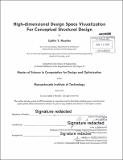High-dimensional design space visualization for conceptual structural design
Author(s)
Mueller, Caitlin T
DownloadFull printable version (8.992Mb)
Other Contributors
Massachusetts Institute of Technology. Computation for Design and Optimization Program.
Advisor
John A. Ochsendorf.
Terms of use
Metadata
Show full item recordAbstract
This thesis focuses on visualizing high-dimensional design spaces for early-stage design problems in structural engineering and related disciplines. The design space, which is defined as the n + 1-dimensional surface that relates n design variables to a performance metric, contains all possible solutions to a formulated design problem. Graphical views of the design space are highly useful for designers because they organize a wide range of design possibilities in a compact, intuitive, and logical manner, illuminating global patterns, variable behaviors and relationships, and the nature of paths taken during iterative design processes. Design problems with two or fewer variables can easily be visualized in Euclidian space, through a curve or surface, but high-dimensional problems are difficult to display graphically. This is the key challenge addressed in this thesis. The thesis includes a critical review of existing methods for high-dimensional design space visualization, highlighting the unmet needs across a range of approaches. In response to these needs, the thesis makes a key contribution in the form of a new design space visualization method, called isoperforming parallel coordinate clusters (IPC clusters), that overcomes the issues of previous techniques. The IPC cluster approach is demonstrated on several conceptual structural design problems, and its application in optimization, directed exploration, and related design strategies is illustrated. Finally, the thesis concludes with a discussion of applications, impact, and future research directions. Key words: design space visualization, conceptual design, structural design, structural optimization
Description
Thesis: S.M., Massachusetts Institute of Technology, Computation for Design and Optimization Program, 2014. Cataloged from PDF version of thesis. Includes bibliographical references (pages 63-66).
Date issued
2014Department
Massachusetts Institute of Technology. Computation for Design and Optimization ProgramPublisher
Massachusetts Institute of Technology
Keywords
Computation for Design and Optimization Program.